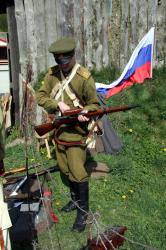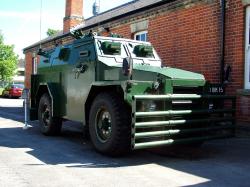Translate this Page
Sanna's Post (Koornspruit Drift)
Battle Name : Sanna's Post (Koornspruit Drift)
Date(s) : 31 March 1900
Part of : The 2nd Boer War (or Three Years War) ,
Outcome : A victory for Boer forces over British Colonial forces
Type of battle : Land
Summary
A brilliantly executed ambush by Boer Forces under Christiaan de Wet over superior British forces under Brigadier-General Broadwood.
Location
South of Bloemfontein, Orange Free State (South Africa) (South Africa)
More details
On 30 March 1900, a British convoy consisting of 92 wagons, 2 horse artillery batteries and 1,700 men under the command of Major-General Broadwood was retreating from Thaba Nchu in the direction of Bloemfontein following reports of sizeable movements of Boer forces in the direction of Thaba Nchu. The force camped for the night at the Bloemfontein waterworks near Sannaspost and Koornspruit Drift.
In the meantime, Generaal Christiaan de Wet had detached 400 men from his force to take the Bloemfontein waterworks under his personal leadership. At Koornspruit Drift, he became aware of the changed situation and, instead of assaulting the waterworks, he decided to ambush Broadwood's larger force as it moved on towards Bloemfontein.
At dawn, Krupp shells from Piet de Wet\'s force behind Broadwood hastened the British on. Broadwood decided to make a dash for the protection of other British forces at Bushman\'s Kop. He failed to set a vanguard and the convoy was led by civilian wagons. Disappearing from view as they descended into Koornspruit Drift, each successive wagon was quietly captured by the burghers under Christiaan de Wet. The soldiers were disarmed and placed under guard. Only at about 08.00 was the alarm raised and the real battle began. The British suffered heavy losses at first, surprised by the Boer fire. In the course of the action, most of the British guns (7 out of 12) were captured because their crews were fighting within effective rifle range of the enemy.
At about noon, threatened by a British mounted brigade to his flank, De Wet decided on a policy of \'judicious disengagement\' and withdrew eastwards across the Modder River, taking the captured British guns, ammunition and prisoners with them. They also destroyed the pump installations, though this, as history makes plain, still did not budge the British from Bloemfontein.
The British suffered 18 killed, 134 wounded and 426 taken prisoner. They also lost 7 guns, 96 loaded wagons, 21 other vehicles and a substantial amount of arms and ammunition including 2 wagon loads of artillery shells. The Boer losses were 5 burghers killed and 11 wounded.
The first major offensive action by Boer forces after the fall of Bloemfontein (13 March 1900), this victory gave the Boers renewed confidence and will to resist the British occupation. De Wet's Commando also gained valuable weapons and supplies, including 7 field-guns and 2 wagon loads of artillery shells.
[Entry provided by Chris Smith of the Heilbron Commando - see Links]
Casualty figures
Boer forces
- Number engaged :
- 400
- Casualties :
- 16 (4.00%)
British Colonial forces
- Number engaged :
- 1,700
- Casualties :
- 578 (34.00%)






